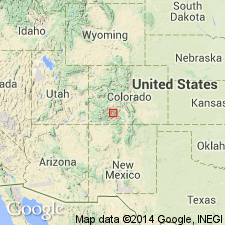
- Usage in publication:
-
- Nelson Mountain quartz latite*
- Modifications:
-
- Original reference
- Dominant lithology:
-
- Quartz latite
- AAPG geologic province:
-
- San Juan Mountains province
Summary:
Nelson Mountain quartz latite of Piedra group of Potosi volcanic series. The upper flow, 0 to 350 feet thick, of Piedra group (Potosi volcanic series) in Creede district, southwestern Colorado. Is a quartz latite of uniform character. Age is Miocene. Younger than Rat Creek quartz latite.
Named for fact it is cap rock on Nelson Mountain, [in SW/4 sec. 1, T. 42 N., R. 1 W., Lat. 37 deg. 54 min. 57 sec. N., Long. 106 deg. 56 min. 14 sec. W., San Luis Peak 7.5-min quadrangle], Creede district, Mineral Co., southwestern CO. [Additional locality information from USGS GNIS database, USGS historical topographic map collection TopoView; accessed February 28, 2013.]
Source: US geologic names lexicon (USGS Bull. 896, p. 1475).

- Usage in publication:
-
- Nelson Mountain Quartz Latite*
- Modifications:
-
- Revised
- AAPG geologic province:
-
- San Luis basin
Summary:
Revised to include all rocks formerly included in Equity Quartz Latite (abandoned). Nelson Mountain and Equity intergrade, forming a single genetic unit. Is a composite ash-flow sheet that changes from a simple cooling unit of predominately densely welded tuff in the Nelson Mountain area into a compound cooling unit to the east and the west. Phenocrysts (mostly plagioclase and lesser clinopyroxene, quartz, sanidine, hornblende, and magnetite) range from 20 to 50 percent of the formation. Ranges from 0 to 500 ft. Known in the Nelson Mountain to Snow Mesa areas, and on the crest of the La Garita Mountains east of Half Moon Pass 9 mi north of Creede, Saguache Co, CO in the San Luis basin. Assigned to the middle and late Tertiary, younger than Rat Creek Quartz Latite and older than Snowshoe Mountain Quartz Latite.
Source: GNU records (USGS DDS-6; Denver GNULEX).

- Usage in publication:
-
- Nelson Mountain Tuff*
- Modifications:
-
- Revised
- AAPG geologic province:
-
- San Juan Mountains province
- San Luis basin
Summary:
Pg. A32-A33, A80-A82. Nelson Mountain Tuff. Divided into (ascending): unnamed outflow member and Cochetopa Park Member (new). Underlies Snowshoe Mountain Tuff; overlies Rat Creek Tuff. The Rat Creek and Nelson Mountain Tuffs are lithologically similar, compositionally zoned ash-flow sheets derived in close succession from nearby calderas (San Luis caldera and Cochetopa Park caldera, respectively). Rocks of equivalent composition in each formation, particularly the quartz latitic rocks, are so similar that they cannot easily be distinguished, whereas rocks of contrasting composition within either formation vary widely in appearance. As a result, during local detailed studies in the Creede mining district, Steven and Ratte (1964, USGS Prof. Paper 475-D, p. D60-D61; 1965, USGS Prof. Paper 487, p. 37) mistakenly correlated intracaldera quartz latitic Rat Creek Tuff in the core of the San Luis caldera with virtually identical Nelson Mountain Tuff across a fault. The correct interpretation became apparent only after broad regional studies provided the proper geologic context. The Nelson Mountain Tuff was erupted from the Cochetopa Park caldera shortly after the Rat Creek Tuff was erupted from the San Luis caldera, and the two caldera cycles overlapped in time. Age is late Oligocene.
[Recognized in Mineral, Hinsdale, and Saguache Cos., southwestern CO.]
Source: Publication.

- Usage in publication:
-
- Nelson Mountain Tuff*
- Modifications:
-
- Revised
- AAPG geologic province:
-
- San Juan Mountains province
- San Luis basin
Summary:
Traces history of confusion of use of Rat Creek, Nelson Mountain, and Cochetopa Park Tuffs. Authors believe original correlation of Nelson Mountain Tuff with the Equity Member in the San Luis caldera is correct. It is therefore removed from Rat Creek Tuff and reassigned to Nelson Mountain Tuff. Cochetopa Park Member, which is younger than Nelson Mountain and is derived from the Cochetopa Park caldera, is removed from Nelson Mountain and given formation status. Nelson Mountain Tuff occurs in Mineral and Hinsdale Counties, Colorado (San Juan Mountain province), and in Saguache County, Colorado (San Luis basin); see fig. 23. Is predominantly a zoned rhyolite to quartz latite in composition. Related to the San Luis caldera. Had an estimated volume of about 500 cubic km. Age is greater than 26.4 m.y. and less than 26.7 m.y.
Source: Modified from GNU records (USGS DDS-6; Denver GNULEX).

- Usage in publication:
-
- Nelson Mountain Tuff*
- Modifications:
-
- Geochronologic dating
- AAPG geologic province:
-
- San Juan Mountains province
Summary:
Nelson Mountain Tuff. Is an ash-flow sheet associated with San Luis caldera in central San Juan Mountains, southwestern Colorado. High-resolution 40/39Ar geochronology (unpublished data, M. Lanphere, USGS) yielded age of 25.9 Ma [late Oligocene].
Source: Modified from GNU records (USGS DDS-6; Denver GNULEX).
For more information, please contact Nancy Stamm, Geologic Names Committee Secretary.
Asterisk (*) indicates published by U.S. Geological Survey authors.
"No current usage" (†) implies that a name has been abandoned or has fallen into disuse. Former usage and, if known, replacement name given in parentheses ( ).
Slash (/) indicates name conflicts with nomenclatural guidelines (CSN, 1933; ACSN, 1961, 1970; NACSN, 1983, 2005, 2021). May be explained within brackets ([ ]).

